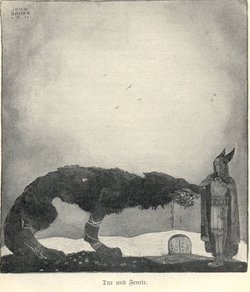Fenrisulfr
|
|
In Norse mythology, the Fenrisulfr, Wolf of Fenrir or simply Fenrir is a monstrous wolf, the son of Loki and the giantess Angrboða. Fenrir is bound by the gods, but is ultimately destined to slip his bonds and devour Odin during the course of Ragnarök, before being slain by Odin's son, Viðarr, who will either stab him in the heart or rip his jaws asunder according to different accounts.
The most important source of our information about Fenrir appears in the "Gylfaginning" section of Snorri Sturluson's Edda, although there are other, often contradictory, accounts and sources which need to be assessed (e.g. in Lokasenna Loki threatens Thor with destruction by Fenrir at the forthcoming Ragnarök once Fenrir has destroyed Odin).
Fenris_Ledbergsstenen_20041231.jpg
Fenrir has two sons, Hati ('hate') and Skoll. These sons chase the horses Árvakr and Alsviðr, that drag the chariot which contains the sun. Hati also chases Máni, the moon. It should be noted that Skoll, in certain circumstances, is used as a heiti to refer indirectly to the father (Fenrir) and not the son (and this ambiguity works in the other direction also, for example in the Vafþrúðnismál, a confusion exists in stanza 46 where Fenrir is given the sun-chasing attributes of his son Skoll).
Learning from the prophecy of the sybil (q.v. Völuspá) and from his contest with Vafþrúðnir (related in Vafþrúðnismál) that the children of Loki and Angrboða would bring trouble to the gods, Odin had the wolf brought to him along with his brother Jörmungandr and his sister Hel.
After casting Jörmungandr into the sea and Hel down into the land of the dead, Odin had the wolf raised among the Æsir. Only the god Týr was daring enough to feed the growing monster. The gods urged by the wolf's increasing strength and by prophecies that he would be their destruction, attempted to bind the great beast. Twice he agreed to be chained and twice easily burst out of two successive fetters. The first, made of iron, was called Lœðingr. The second, also of iron, but of twice the strength, was called Drómi.
Odin then had the dwarfs forge the chain Gleipnir ("deceiver" or "entangler"). It appeared to be only a silken ribbon but was made of six wondrous ingredients: the sound of a cat's footfall, the beard of a woman, the roots of a mountain, bear's sinews (meaning nerves, sensibility), fish's breath, and bird's spittle (which explains why these things are not found today). Skírnir, Freyr's messenger, brought it back to Ásgarðr.
Then, in the island called Lyngvi ("Heathery") in the lake called Ámsvartnir 'Red-black' (places unknown to us), the gods challenged Fenrisulfr to break this chain also. But the wolf noted the thinness and fineness of construction of Gleipnir and not unreasonably suspected a trick. He agreed to make the test only if one of the gods was willing to place his hand in the wolf's mouth during the binding as a pledge to free him if he failed to break the chain. No god was willing to do this, until Týr stood forth and placed his hand in the wolf's mouth. Fenrisulfr strained to burst the chain but the more he struggled the tighter he was held. When the gods would not free him, the wolf bit off Týr's hand at the point afterwards called "the wolf joint".
Then, as told by Snorri in Brodeur's translation:
When the Æsir saw that the Wolf was fully bound, they took the chain that was fast to the fetter, and which is called Gelgja 'Thin', and passed it through a great rock—it is called Gjöll 'Scream'—and fixed the rock deep down into the earth. Then they took a great stone and drove it yet deeper into the earth—it was called Thviti—and used the stone for a fastening-pin. The Wolf gaped terribly, and thrashed about and strove to bite them; they thrust into his mouth a certain sword: the guards caught in his lower jaw, and the point in the upper; that is his gag. He howls hideously, and slaver runs out of his mouth: that is the river called Ván 'Hope'; there he lies till the Weird of the Gods.
It is prophesied that at Ragnarök the wolf will at last break free and join forces with the enemies of the gods and will then devour Odin himself. After that Viðarr, Odin's son, will slay the wolf to avenge his father, either with a sword through the heart, or by tearing apart the wolf after placing one foot shod with a special shoe on its lower jaw and one hand on its upper jaw.
Other names
- Fenrisúlfr
- Fenris Wolf (a translation of Fenrisulfr)
- Fenrir (along with Fenris as one of the more accepted)
- Skoll (heiti), often ambiguous
- Hróðvitnir, 'the famous wolf'
Fenris Ulf is one of the White Witch's servants, an enormous wolf, in old American editions of The Lion, the Witch, and the Wardrobe by C. S. Lewis. His name, and to some extent his characterization, is derived from the mythological Fenrisulfr.da:Fenrisulven de:Fenriswolf es:Fenris fr:Fenrir ja:フェンリル nb:Fenrisulven nl:Fenrir nn:Fenrisulven pl:Fenris pt:Fenrir sv:Fenrisulven uk:Фенрір

